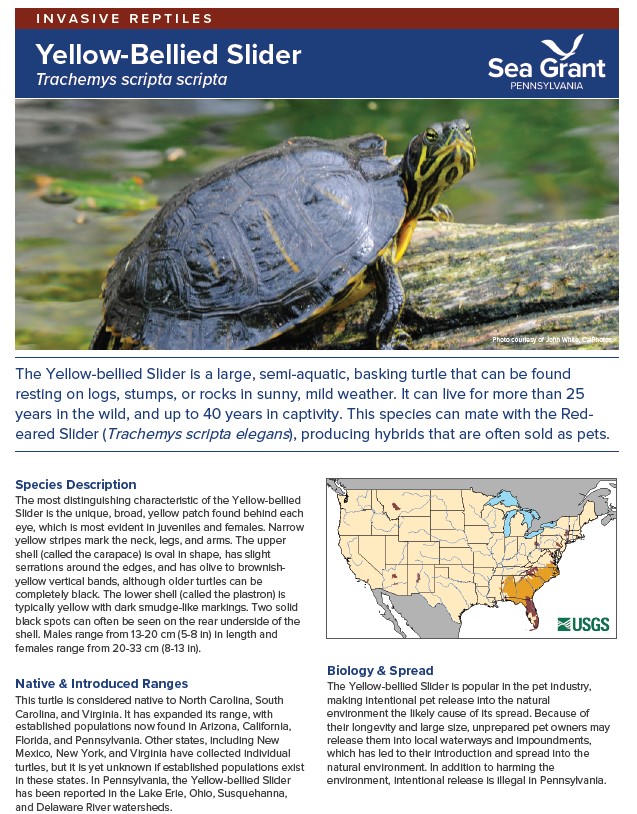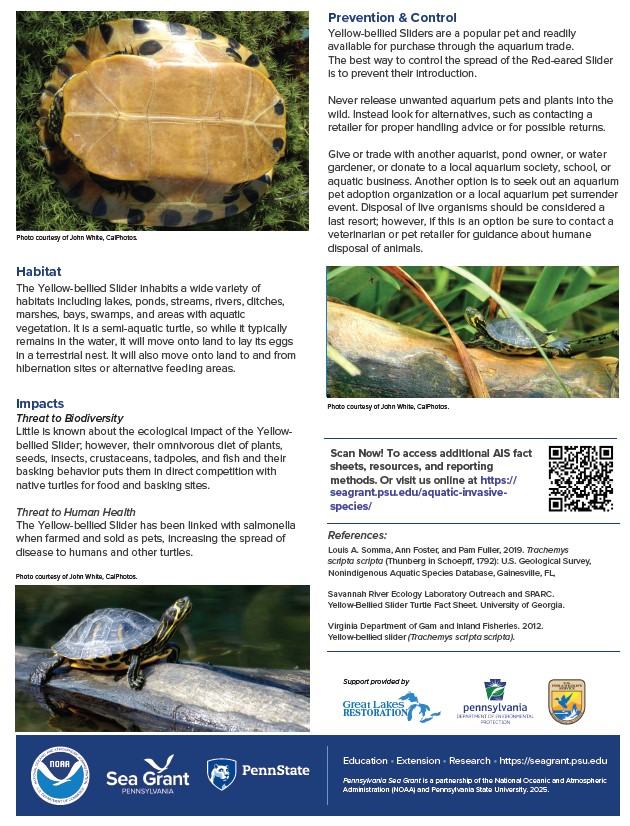Yellow-Bellied Slider (Trachemys scripta scripta)
Species at a Glance
The Yellow-bellied Slider is a large, semi-aquatic, basking turtle that can be found resting on logs, stumps, or rocks in sunny, mild weather. It can live for more than 25 years in the wild, and up to 40 years in captivity. This species can mate with the Red-eared Slider (Trachemys scripta elegans), producing hybrids that are often sold as pets.


Species Description
The most distinguishing characteristic of the Yellow-bellied Slider is the unique, broad, yellow patch found behind each eye, which is most evident in juveniles and females. Narrow yellow stripes mark the neck, legs, and arms. The upper shell (called the carapace) is oval in shape, has slight serrations around the edges, and has olive to brownish-yellow vertical bands, although older turtles can be completely black. The lower shell (called the plastron) is typically yellow with dark smudge-like markings. Two solid black spots can often be seen on the rear underside of the shell. Males range from 13-20 cm (5-8 in) in length and females range from 20-33 cm (8-13 in).
Native & Introduced Ranges
This turtle is considered native to Virginia, North Carolina, South Carolina, and Virginia. It has expanded its range, with established populations now found in Arizona, California, Florida, and Pennsylvania. Other states, including New Mexico, New York, and Virginia have collected individual turtles, but it is yet unknown if established populations exist in these states. In Pennsylvania, the Yellow-bellied Slider has been reported in the Lake Erie, Ohio, Susquehanna, and Delaware River watersheds.
Biology & Spread
The Yellow-bellied Slider is popular in the pet industry, making intentional pet release into the natural environment the likely cause of its spread. Because of their longevity and large size, unprepared pet owners may release them into local waterways and impoundments, which has led to their introduction and spread into the natural environment. In addition to harming the environment, intentional release is illegal in Pennsylvania.
Habitat
The Yellow-bellied Slider inhabits a wide variety of habitats including lakes, ponds, streams, rivers, ditches, marshes, bays, swamps, and areas with aquatic vegetation. It is a semi-aquatic turtle, so while it typically remains in the water, it will move onto land to lay its eggs in a terrestrial nest. It will also move onto land to and from hibernation sites or alternative feeding areas.
Impacts
Threat to Biodiversity
Little is known about the ecological impact of the Yellow-bellied Slider; however, their omnivorous diet of plants, seeds, insects, crustaceans, tadpoles, and fish and their basking behavior puts them in direct competition with native turtles for food and basking sites.
Threat to Human Health
The Yellow-bellied Slider has been linked with salmonella when farmed and sold as pets, increasing the spread of disease to humans and other turtles.
Prevention & Control
Yellow-bellied Sliders are a popular pet and readily available for purchase through the aquarium trade.
The best way to control the spread of the Red-eared Slider is to prevent their introduction.
Never release unwanted aquarium pets and plants into the wild. Instead look for alternatives, such as contacting a retailer for proper handling advice or for possible returns.
Give or trade with another aquarist, pond owner, or water gardener, or donate to a local aquarium society, school, or aquatic business. Another option is to seek out an aquarium pet adoption organization or a local aquarium pet surrender event. Disposal of live organisms should be considered a last resort; however, if this is an option be sure to contact a veterinarian or pet retailer for guidance about humane disposal of animals.
References:
Louis A. Somma, Ann Foster, and Pam Fuller, 2019. Trachemys scripta scripta (Thunberg in Schoepff, 1792):
U.S. Geological Survey, Nonindigenous Aquatic Species Database, Gainesville, FL.
Savannah River Ecology Laboratory Outreach and SPARC. Yellow-Bellied Slider Turtle Fact Sheet. University of Georgia.
Virginia Department of Gam and Inland Fisheries. 2012. Yellow-bellied slider (Trachemys scripta scripta).



